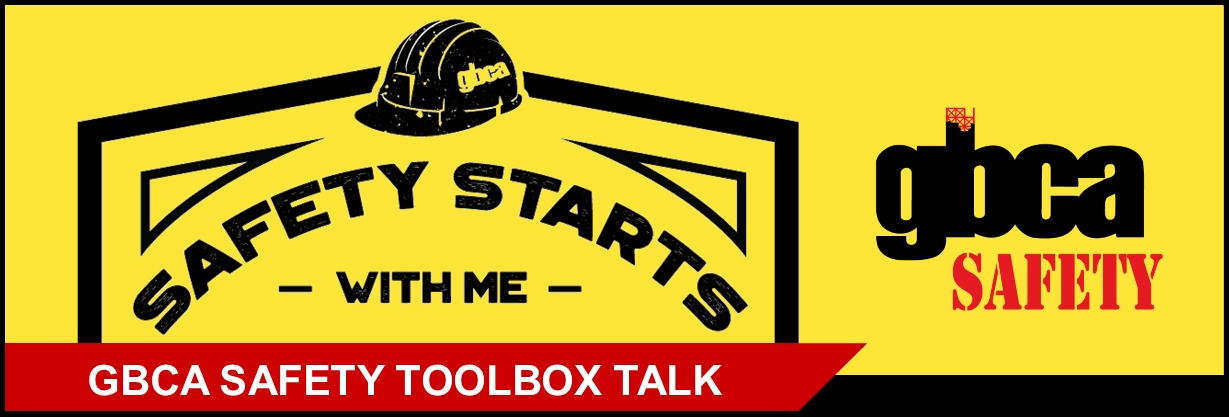This GBCA Safety Toolbox Talk provides tips for working in the cold. This toolbox talk covers common cold-related stress injuries, and tips for avoiding them. Click below to download the Toolbox Talk as a handout (includes Sign-In Sheet).
Working in the Cold
As temperatures dip during the winter months, construction workers face the occupational hazard of exposure to the cold. Workers need to be especially mindful of the weather, its effects on the body, and how to keep warm and safe during these days.
There are 4 conditions that lead to cold-related stress injuries. Prepare yourself against these conditions:
- Low temperatures
- High/cool winds
- Dampness
- Cold water
Common Cold-Related Stress Injuries
Trench Foot
Trench foot is a non-freezing injury of the feet caused by prolonged exposure to wet and cold conditions. Wet feet lose heat 25-times faster than dry feet. If feet are constantly wet, trench foot can occur in temperatures as high as 60°F. Symptoms include,
- Reddening skin
- Tingling
- Pain
- Swelling
- Leg cramps
- Numbness
- Blisters
Frostbite
Frostbite is caused by the freezing of the skin and tissues. Frostbite can cause permanent damage to the body. Severe cases may require amputation. The risk of frostbite is increased in people with reduced blood circulation and among people who are not dressed properly for extremely cold temperatures. Frostbite can occur without hypothermia. Symptoms include,
- Tingling in affected body parts
- Numbness
- Changes in skin color
- Subsiding pain as the condition worsens
- Blisters may form in affected areas
Hypothermia
Hypothermia affects the victim’s brain, making it difficult to know if it’s happening to yourself, and you may not be able to do anything about it. Look out for the following symptoms for yourself and from your colleagues:
- Uncontrollable shivering
- Slow heartbeat and weakened pulse
- Severe shaking
- Stiff muscles
- Slurred speech
- Memory lapses
- Drowsiness
- Lowered body temperature that leads to,
- Cool skin
- Slow and irregular breathing
- Exhaustion
- Inability to think clearly
- Difficulty moving well
For any cold-related stress injury, get immediate medical attention.
Protect Yourself from Cold Conditions
One of the easiest ways to protect yourself from cold conditions is to wear weather-appropriate clothing. Wearing inadequate or wet clothing increases the effects of cold on the body.
Wear the Right Types of Clothing
- Wear at least three layers of clothing:
- An outer layer to break the wind and allow some ventilation.
- A middle layer of wool or synthetic fabric to absorb sweat and retain insulation in a damp environment.
- Inner layers of cotton or synthetic weave to allow for proper ventilation.
- Pay special attention to protecting feet, hands, face, and head. Up to 40 percent of body heat can be lost when the head is exposed.
- Wear a cold-weather hard hat liner approved by ANSI and the hat’s manufacturer. DO NOT wear a regular knit winter cap under your hard hat—these decrease the hat’s effectiveness.
- Approved neck gaiters can help protect the face and ears.
- Wear insulated footgear to protect against cold and dampness.
- Avoid cotton socks. Wool or comparable synthetic materials better insulate heat when wet.
- Keep a change of clothing, including underwear, in case work clothes become wet.
Monitor Your Physical Condition
Check Your Health
Some personal conditions pose a greater hazard in cold weather:
- Taking certain drugs or medications such as alcohol, nicotine, caffeine, can inhibit the body’s response to the cold and impair judgment.
- Having a cold or certain diseases, such as diabetes, heart, vascular, and thyroid problems, may make a person more susceptible to the winter elements.
Practice Safe Work Habits
- Stay as dry as possible. Moisture, including sweat, can increase the rate of heat loss from the body.
- Take breaks in warm, dry areas. Dry off as much as possible if necessary.
- Drink warm fluids (no alcohol).
Prepare for Being Stranded in Your Vehicle
- 70% of deaths during snow or ice storms occur in vehicles. Carry blankets or sleeping bags, matches, hand warmers, candles, a snow shovel and sandbags, a flashlight, and food such as cereal bars, in case a winter storm strands you in your vehicle.
- Remember to crack a window open to allow in fresh air!
Remember to record the attendees of your toolbox talk!
Access GBCA’s full library of toolbox talks:





